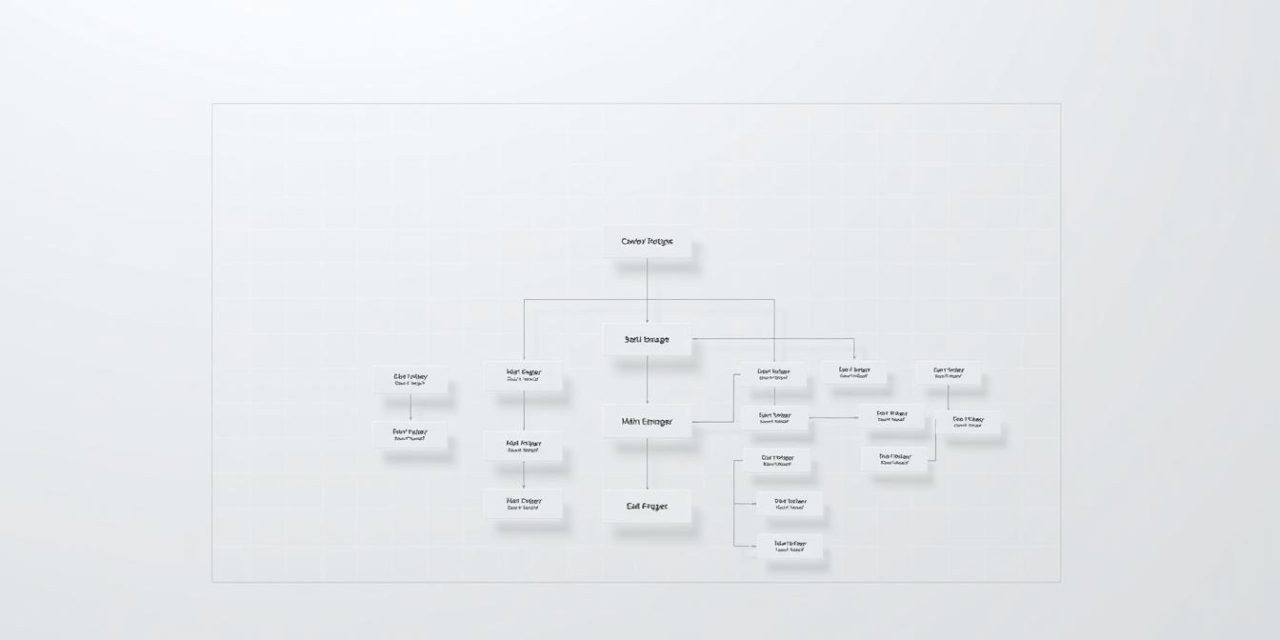Imagine walking into a library where all the books are piled in the center of the room. Finding what you need would be a frustrating challenge. A website without a clear plan creates the same experience for your visitors.
Research shows that 94% of first impressions are design-related. This means a poor layout can cause you to lose potential customers immediately. Your website’s organization acts as a roadmap, guiding both people and search engines.
A thoughtful site structure makes it easy for users to navigate. They can quickly find the information or products they want. This smooth experience keeps them engaged and more likely to become customers.
For SEO, a logical structure is equally vital. It helps Google understand your content and decide which pages are most important. This leads to better rankings and more organic traffic.
This guide will show you how to build a solid foundation for your online presence. You’ll learn to organize your content effectively and avoid common mistakes that hurt visibility.
Table of Contents
Key Takeaways
- First impressions are heavily influenced by your website’s design and organization.
- A clear structure acts as a guide for both human visitors and search engine crawlers.
- Easy navigation is crucial for keeping users on your website and encouraging conversions.
- Search engines rely on your site’s organization to index content and determine relevance.
- A well-planned structure prevents your own pages from competing against each other in search results.
- Building a logical website from the start saves time and improves performance in the long run.
Introduction to Website Structure and Its SEO Benefits
The way you arrange your web pages determines how easily people and technology can explore your content. A clear plan for your online presence is not just about looks. It is the invisible framework that supports everything you do.
Defining Website Structure
Think of your page hierarchy as a family tree for your information. Your homepage is the parent. Main sections, like « Services » or « Blog, » are the children. Individual articles or product details are the grandchildren.
Internal links are the pathways connecting this family. They show the relationship between different pieces of content. This organization helps visitors find what they need without getting lost.
How Layout Impacts Search Engine Rankings
A logical arrangement is a powerful SEO tool. It sends clear signals to Google and other platforms about your most valuable material. This helps them understand your main topics.
When your layout is efficient, search bots can crawl and index all your pages faster. This means your content has a better chance of appearing in search results.
- Faster Indexing: Search engines can find and list your new pages quickly.
- Improved Rankings: A clear hierarchy helps engines see which pages are most important for specific searches.
- Topical Authority: Grouping related content shows you are an expert in your field.
Understanding « Site Structure » and Its Role
A website’s organizational framework is like the blueprint of a building—it determines how everything fits together. This foundation guides both visitors and search engines through your digital space.

Different approaches work for different goals. The right choice depends on what you want to achieve with your online presence.
Key Concepts Behind Effective Structures
There are four main ways to organize your web pages. Each serves a unique purpose for different types of content.
The hierarchical model works like a pyramid. Your homepage sits at the top with categories flowing downward. This works well for most business websites.
Sequential layout guides users step-by-step. It’s perfect for tutorials or checkout processes where order matters.
Matrix organization allows free movement between related content. Think of news sites where multiple pathways connect information.
Database structures generate pages dynamically based on user needs. Large e-commerce platforms often use this approach.
Information Architecture (IA) is the discipline behind great organization. It ensures your content makes sense to visitors.
The most effective websites often blend elements from different types. This creates a unique experience that serves both users and business goals.
The Impact of a Well-Organized Structure on User Experience
A visitor’s ability to smoothly move through your online content directly influences their overall impression. When people can’t find what they need quickly, frustration sets in. This negative experience often leads them to leave and never return.
The arrangement of your web presence plays a crucial role in visitor satisfaction. Think of it as creating clear pathways rather than confusing mazes. People appreciate when they can intuitively understand where to find specific information.
Good organization reduces mental effort for your audience. When content appears in logical groups, visitors process information more easily. They remember where to find things on future visits.
Improving Navigation and Usability
Clear menus and intuitive labels guide people effectively. Your navigation system should feel like a helpful map. Visitors should never wonder where to click next.
When users find relevant pages quickly, they stay longer and explore more. This increased engagement leads to higher conversion rates. Whether you want sales, sign-ups, or content consumption, smooth navigation delivers results.
Accessibility improves with thoughtful organization too. Screen readers and assistive technologies work better with clear hierarchies. Everyone benefits from a well-planned digital space.
How Search Engines Evaluate Your Site Hierarchy
The organization of your web pages sends powerful signals to search engines about the value and relevance of your content. A clear layout acts like a fluent language that Google and other platforms easily understand. This understanding is built through three key activities: crawling, indexing, and ranking.

Think of these activities as a three-step evaluation process. Each step relies on the logical connections you build between your pages.
A flat hierarchy, where important content is just a few clicks from the homepage, helps search engines discover your pages faster and distribute authority more effectively.
Crawling, Indexing, and Ranking Fundamentals
First, automated bots explore your website by following internal links. They start from your homepage and travel through your navigation. If a page has no links pointing to it, crawlers may never find it.
After discovery, the indexing phase begins. Search engines analyze and store information about each page in a massive database. A logical arrangement helps them understand what each piece of content is about.
Finally, ranking determines which pages appear in search results for a query. Engines use the signals gathered during crawling and indexing to pick the most authoritative and relevant pages.
| Process | Primary Goal | How Hierarchy Helps |
|---|---|---|
| Crawling | Discover all pages | Clear internal links ensure no page is missed. |
| Indexing | Understand page content | Logical grouping shows topical relationships. |
| Ranking | Determine result order | Identifies cornerstone content worthy of high positions. |
Search engines also look at the context surrounding your links. The words near a hyperlink provide extra clues about the linked page’s topic. This context helps Google value your content properly.
Building a Pyramid: Homepage, Categories, and Subcategories
The pyramid approach to website organization creates a natural flow that guides visitors intuitively through your content. This method places your most important information at the top, with more specific details organized beneath it.
This hierarchical arrangement benefits both human visitors and search engines. People can quickly understand how your content relates, while Google can efficiently crawl and index your pages.
Role of the Homepage as a Navigation Hub
Your homepage acts as the central command center for your entire website. It should feature clear links to your most important categories and key landing pages.
Strategic linking from your homepage accomplishes two crucial goals. It directs visitors toward content you want them to see while signaling to search engines which pages deserve priority.
Utilizing Categories and Subcategories Effectively
Categories form the second level of your pyramid, representing your main topics or product types. They become the primary sections in your main navigation menu.
For larger websites, subcategories prevent main categories from becoming overcrowded. They break broad topics into more specific, manageable groups that are easier to navigate.
| Pyramid Level | Purpose | Example |
|---|---|---|
| Homepage | Central navigation hub | Links to main categories |
| Categories | Main topic organization | Women’s Clothing, Electronics |
| Subcategories | Specific content grouping | T-shirts, Laptops, Accessories |
| Individual Pages | Detailed content/products | Product details, blog posts |
This pyramid structure ensures most content remains within 3-4 clicks from your homepage. This flat architecture improves both user experience and SEO performance.
Mastering Internal Linking Strategies
The strategic placement of links between your pages can transform a collection of individual articles into a powerful, interconnected knowledge base. This approach helps both visitors and search engines understand the relationships within your content.
Contextual Linking Best Practices
Contextual links are those placed naturally within your page content. They point readers to related information that adds value to their current reading experience. The key is ensuring each link serves a genuine purpose.
Search engines analyze both the anchor text and surrounding content to understand what your linked page is about. This context helps them determine relevance and authority for specific topics.
| Linking Approach | Best Use Case | SEO Benefit |
|---|---|---|
| Contextual Links | Within article content | High relevance signaling |
| Navigation Links | Menus and footers | Structural clarity |
| Related Posts | End of articles | Extended engagement |
For content-rich websites, identify your cornerstone articles—comprehensive posts on important topics. Create supporting blog posts that link back to these main resources. This hub-and-spoke model strengthens your authority.
This strategy also prevents keyword cannibalization by clearly signaling which page should rank for specific searches. Your most important content receives the most relevant internal links.
Enhancing Navigation with Menus and Breadcrumbs
Think of your website’s navigation as a friendly guide, always ready to show visitors exactly where they want to go. A clean and intuitive menu is your primary tool for this. It should list your main categories using simple, clear language that anyone can understand.
Avoid jargon. Labels must tell people what they will find. Too many options can overwhelm users. A good rule is to keep top-level menu items to seven or fewer.
For larger websites, a second menu can be a great solution. This prevents clutter. For example, a top bar can hold links for account pages or help sections. This creates a smooth navigation experience for different user needs.
Creating a Clean, User-Friendly Menu
Your menu is the most common aid for navigation. It needs to be organized logically. Main categories should have a clear place. This helps visitors understand your content at a glance.
For extensive product ranges, multiple menus work well. They allow you to highlight important pages without crowding the main navigation. The goal is to make exploration easy and frustration-free.
The Value of Breadcrumb Paths
Breadcrumbs are a secondary navigation aid. They are clickable links, usually at the top of a page. They show the path from the homepage to the current page.
This trail is incredibly helpful. It lets users see their location and easily backtrack. It is especially valuable on e-commerce sites with deep category levels.
Breadcrumbs also send positive signals to search engines. They clarify the relationship between your pages. This improves both user experience and SEO.
| Navigation Element | Primary Benefit | Best Practice |
|---|---|---|
| Main Menu | Primary access to key sections | Use clear labels, limit top items to ~7 |
| Utility Menu | Quick links for account/help | Place in header, keep concise |
| Breadcrumbs | Shows current location and path | Implement on all pages except homepage |
Most modern CMS platforms offer built-in breadcrumb features or plugins. They are easy to implement and style to match your design. This small addition provides a significant boost to how people interact with your pages.
Content Organization Tactics: Categories, Tags, and Blog Posts
Think of your website’s content as a well-organized filing system where categories serve as the main drawers and tags as the detailed labels. This dual approach helps visitors navigate your material with ease.

Grouping Content for Clarity
Categories function like chapters in a book. They group related blog posts under broad themes. This creates a clear pathway for users exploring your content.
When a category accumulates too many posts, consider adding subcategories. For example, a « Marketing » category might split into « Email Marketing » and « Social Media Marketing. » This prevents overwhelming visitors with excessive options.
As one expert notes, « Categories provide the scaffolding that supports your entire content ecosystem. » They help search engines understand your topical focus.
Balancing Categories and Tags for Better UX
Tags work differently from categories. They represent specific attributes that cross multiple categories. Think of them as an index rather than a table of contents.
Effective tagging requires restraint. Create tags only when they group at least two pieces of content. This prevents tag bloat that confuses visitors.
For e-commerce platforms, the same principles apply. Products belong to categories while tags might indicate brands or materials. This enhances navigation for shoppers.
| Feature | Categories | Tags |
|---|---|---|
| Hierarchy | Supports subcategories | Flat organization |
| Purpose | Broad content grouping | Specific attributes |
| Best Use | Main topics and themes | Cross-category connections |
Display tags visibly at the bottom of articles or in sidebars. This encourages exploration of related content. The right balance between categories and tags creates a seamless user experience.
Responsive Design and Mobile-Friendly Site Structures>
In today’s mobile-first world, your website’s adaptability across devices isn’t just a feature—it’s fundamental to reaching your audience effectively. With over half of all web traffic now coming from smartphones, a non-responsive design creates barriers for users.
Pages that fail to adjust properly lead to frustrating navigation and poor readability. This negative experience often causes visitors to leave quickly.
Optimizing Layouts for Multiple Devices
Responsive design ensures your content looks great on any screen size. Interactive elements like buttons and forms must be touch-friendly on mobile devices.
Testing across various screens is essential. Tools like Chrome DevTools help verify your layout works everywhere. The mobile experience differs significantly from desktop.
Users on phones often seek quick information like contact details. Desktop visitors may research more thoroughly. Your design should accommodate both types of users.
Mobile-first design prioritizes the smartphone experience. This approach forces you to focus on essential content and navigation. The result is cleaner, more efficient pages.
Google now uses mobile-first indexing for rankings. A poor mobile experience directly impacts your SEO performance. Ensuring responsive design protects both user satisfaction and search visibility.
SEO and Content Integration: Avoiding Keyword Cannibalization
When your own content starts competing against itself in search results, you’re facing a common but preventable SEO challenge. This internal competition, known as keyword cannibalization, happens when multiple pages target similar search terms.
Instead of working together to boost your authority, these pages battle each other for rankings. This confusion often causes both to rank lower than a single, well-optimized page would.

Maintaining Content Relevance Across Pages
A clear content strategy prevents this issue. Create a keyword map that assigns specific terms to individual pages. Your main product or service pages should target primary keywords.
Supporting articles and blog posts can focus on related long-tail variations. This approach ensures each piece of content serves a distinct purpose in search.
Internal linking plays a crucial role too. When you consistently link from multiple related pages to one cornerstone article, you signal to Google which page is most important for that topic. This optimized content approach strengthens your overall SEO performance.
Regular audits help maintain relevance across all your pages. Check for overlapping target keywords and adjust your strategy as your website grows. This prevents accidental competition between your own valuable content.
Conclusion
The framework that holds your web presence together deserves continuous attention, not just initial planning. A solid website organization is essential for long-term success.
Make this foundation part of your ongoing SEO strategy. As your business grows and adds new products, your navigation should adapt. Regular audits help maintain quality over time.
Tools like flowcharts provide valuable visual planning. They help you see the big picture for better organization. This benefits both visitors and search engines.
Remember, a well-planned website architecture serves your users effectively while supporting your business goals. It’s an investment that pays dividends across all aspects of your online presence.
FAQ
What is website structure, and why is it important?
Think of your website’s structure as its blueprint. It’s how you organize all your pages and content. A good layout helps visitors find what they need quickly. It also makes it easier for search engines like Google to understand and rank your pages.
How does my site’s organization affect search engine rankings?
Search engines love a well-organized website. A clear hierarchy helps their bots crawl and index your content efficiently. When your information is easy to find, it signals quality and relevance, which can boost your rankings in search results.
What are the key elements of a user-friendly navigation system?
Great navigation includes a simple main menu, a logical page hierarchy, and helpful breadcrumb trails. These elements guide users smoothly from your homepage to specific product pages or blog posts, improving their overall experience.
What is the role of internal linking in a good site layout?
Internal links act as pathways connecting your content. They help distribute authority throughout your pages and keep visitors engaged by guiding them to related information. This strategy strengthens your overall web presence.
How should I organize my blog posts and product pages?
Group your content into clear categories and subcategories. For a blog, this might mean topics like « Marketing Tips » or « SEO Guides. » For an online store, use product types and brands. This grouping makes your content much easier to browse.
Why is a mobile-friendly design crucial for my website’s success?
With so many people browsing on phones, a responsive design is essential. It ensures your layout looks great and works perfectly on any device, providing a positive experience for all visitors and meeting search engine preferences.





